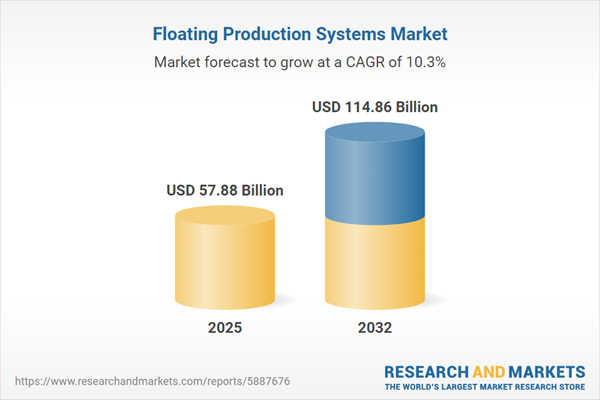Speak directly to the analyst to clarify any post sales queries you may have.
The floating production systems market is redefining how senior executives approach offshore energy projects. Positioned at the center of efficiency, innovation, and sustainability, this segment presents actionable intelligence for leaders aiming to align investment strategy and operational frameworks with the evolving needs of global offshore energy production.
Market Snapshot: Floating Production Systems Market Size and Growth
The global floating production systems market is forecasted to expand from USD 52.36 billion in 2024 to USD 57.88 billion in 2025, reaching USD 114.86 billion by 2032. This results in a compound annual growth rate (CAGR) of 10.31%. This upward trajectory reflects sustained investments in offshore development as organizations transition from less viable onshore reserves toward advanced subsea technologies. Floating platforms remain indispensable to enable efficient oil and gas extraction, strengthen energy transition initiatives, and address both operational and environmental challenges. For senior decision-makers, success depends on strategic scheduling, collaborative supplier engagement, and a steady integration of sustainability principles into operational models.
Scope & Segmentation of the Floating Production Systems Industry
- System Types: Floating production storage and offloading (FPSO) units, floating liquefied natural gas (FLNG) vessels, semi-submersibles, spars, and tension leg platforms form the technological backbone for versatile operations in remote offshore locations. These platforms enable field development flexibility and cost management in both new and mature fields.
- Water Depth Classes: Shallow water, deepwater, and ultra-deepwater classifications define different engineering and logistical requirements, influencing platform selection and deployment strategies tailored to each project's complexity.
- Applications: Greenfield developments support new asset creation, while brownfield redevelopments focus on maximizing value and efficiency through existing offshore infrastructure upgrades to meet evolving operational demands.
- End Use Streams: Integrated oil and gas operations alongside processing-centered projects require customized floating solutions to satisfy shifting regulatory expectations and market trends.
- Hull Materials: Steel and concrete are the main choices for hull construction, offering varying degrees of corrosion resistance and durability selected according to environmental conditions and lifespan priorities.
- Mooring Systems: Dynamic positioning, spread mooring, and turret mooring systems secure floating platforms and are selected for their suitability to differing marine environments, ensuring operational reliability and safety.
- Regional Coverage: The Americas, Europe, Middle East & Africa, and Asia-Pacific each reflect unique combinations of regulatory requirements, market opportunities, and adaptive energy transition methodologies, making region-specific strategies essential.
- Leading Companies: Sector innovators such as MODEC, SBM Offshore, Bumi Armada, BW Offshore, Teekay Offshore Partners, Yinson Holdings, China Oilfield Services, Exmar, Golar LNG, and TechnipFMC drive technological advancement and set operational standards across the floating production systems market supply chain.
Key Takeaways: Strategic Insights for Senior Leadership
- Implementing modular architectures and leveraging advanced digital monitoring platforms grants leaders enhanced visibility, permitting swift operational pivots as offshore conditions and objectives change.
- Emphasizing proactive emissions management and fortifying supply chain transparency improves regulatory adherence and streamlines project planning for greater resilience.
- Continuous advancements in hull and mooring designs are key for mitigating downtime and maintaining adaptability amid evolving offshore environmental pressures and regulations.
- Building collaborative relationships with technology partners, operators, and service providers promotes workforce expertise and smooths alignment with evolving industry benchmarks.
- Developing and diversifying regional supply chains enables more stable procurement, helping to insulate ongoing operations from global market disturbances and logistical challenges.
- Integrating technical performance data with financial and compliance strategies supports structured risk mitigation and effective project management tailored to operational demands.
Tariff Impact on Supply Chain and Cost Structures
New U.S. tariffs on offshore steel and subsea equipment have led companies to adapt procurement strategies. Increasing reliance on domestic and regional suppliers helps stabilize sourcing, ensuring product quality and schedule predictability amid ongoing global trade adjustments.
Methodology & Data Sources
Findings are underpinned by executive interviews, in-depth senior management feedback, and regulatory insights. Analysis draws on comprehensive reviews of technical literature, prominent industry reports, and government-validated data to present an objective foundation for strategic decision-making in floating production systems.
Why This Floating Production Systems Report Matters
- Supports executives in optimizing capital allocation and directing technology investments to bolster competitive standing in the floating production systems market.
- Prepares procurement and operations leaders to anticipate and mitigate supply chain disruptions, respond effectively to changing regulatory environments, and maintain project momentum.
- Enables organizations to identify risk mitigation opportunities, strengthen differentiation strategies, and seize market potential with informed, actionable insights.
Conclusion
Access to robust floating production systems intelligence gives leaders the tools to unlock new growth and maintain steady progress. Unified strategies and informed choices drive resilient performance in a shifting offshore energy landscape.
Additional Product Information:
- Purchase of this report includes 1 year online access with quarterly updates.
- This report can be updated on request. Please contact our Customer Experience team using the Ask a Question widget on our website.
Table of Contents
3. Executive Summary
4. Market Overview
7. Cumulative Impact of Artificial Intelligence 2025
Companies Mentioned
The companies profiled in this Floating Production Systems market report include:- MODEC, Inc.
- SBM Offshore N.V.
- Bumi Armada Berhad
- BW Offshore Limited
- Teekay Offshore Partners L.P.
- Yinson Holdings Berhad
- China Oilfield Services Limited
- Exmar NV
- Golar LNG Limited
- TechnipFMC plc
Table Information
| Report Attribute | Details |
|---|---|
| No. of Pages | 199 |
| Published | October 2025 |
| Forecast Period | 2025 - 2032 |
| Estimated Market Value ( USD | $ 57.88 Billion |
| Forecasted Market Value ( USD | $ 114.86 Billion |
| Compound Annual Growth Rate | 10.3% |
| Regions Covered | Global |
| No. of Companies Mentioned | 11 |









